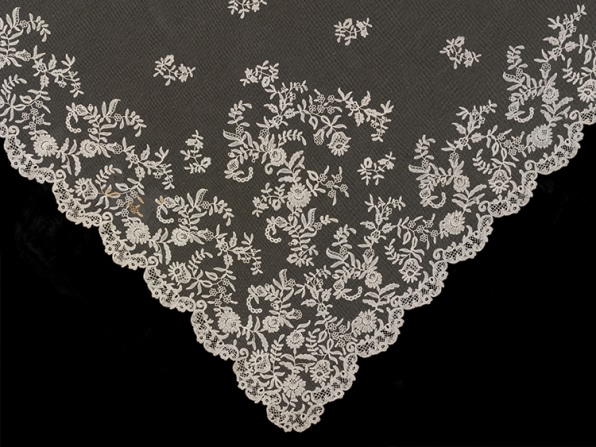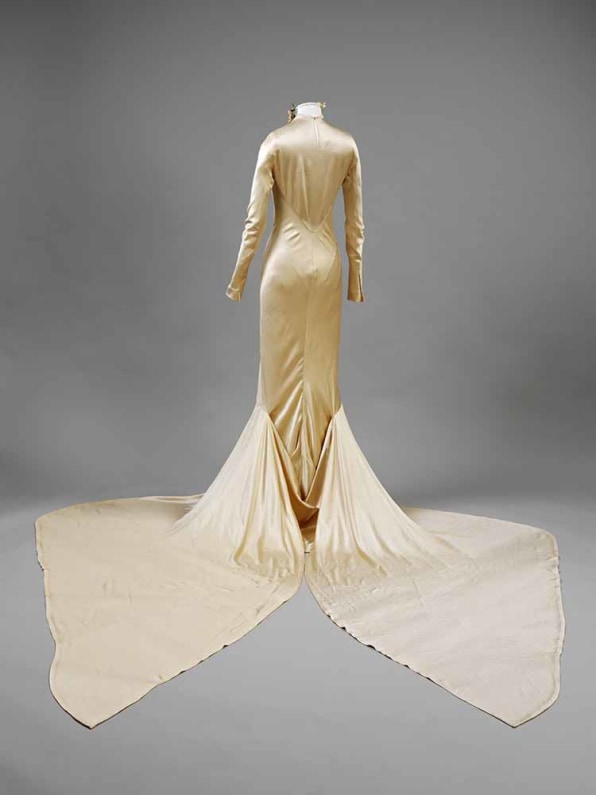Didn't Wedding Dresses Used to All Be Black
Wedding Dresses 1775-2014, a new exhibition at London's Victoria and Albert Museum, offers some insight. It explores not only the history of bridal outfits, but the deeper implications around the cultural moment of any given dress. What's revealed are our attitudes towards sex, love, and class.
The 70 or so confections on view range from antique society dresses to Ian Stuart's Flower Bomb, with a drop-waist bodice and a skirt blossoming with flowers in tulle and lace. Also on show is Gwen Stefani's pink-drenched Dior gown and burlesque superstar Dita Von Teese's purple Vivienne Westwood number. Accessories are included, too, as are outfits worn by bridesmaids, grooms, and page boys.
1840s: The Birth of the White Wedding

Victoria and Albert Museum
"I wore a white satin dress, with a deep flounce of Honiton lace, an imitation of an old design," wrote Queen Victoria, the ultimate trendsetter, in her diary after her 1840 wedding to Prince Albert. At the time, white was an unusual choice for brides, who tilted to more colorful gowns. "Before the 18th century, there were just a few isolated instances of royal brides wearing white," exhibition curator Edwina Ehrman tells Co.Design.
After Victoria wore her white satin dress, white bridal get-ups caught on among the Victorian elite. As the monthly Godey's Lady's Book declared in 1850, "[A white dress] is an emblem of the purity and innocence of girlhood, and the unsullied heart she now yields to the chosen one." And no traits were considered more important for Victorian women than purity and innocence, of course. But white was also a status symbol: "At a time when all washing had to be done by hand, white garments were very difficult to keep clean," Ehrman says. "Only well-to-do-women could afford a dress that could be worn only infrequently or quickly discarded."
1930s: The Wedding Dress as a Hollywood-Worthy Spectacle

Victoria and Albert Museum
The slinky, slim-hipped designs of the '20s and '30s, often made from richly beaded fabrics and bias-cut satin, drew inspiration from evening fashions and Hollywood glamor. The rise of photojournalism meant that society weddings were no longer viewed just by loved ones–they became feverishly publicized spectacles, with extravagant dresses as centerpieces. "The dress of society bride Margaret Whigham, worn in 1934, has real star quality, with dramatic medieval-style hanging sleeves," Ehrman says. "It took 30 seamstresses six weeks to make and cost £52 at a time when a young woman was lucky to earn £1.50p a week."
1940s: Ad Hoc Wartime Dresses
Nuptial extravagance would certainly return decades later, but glamorous design was curtailed by World War II rationing, which extended to fabrics in 1941. Forced to be practical, brides had to innovate with non-rationed materials; they sewed dresses from net curtaining, parachute silk, and upholstery instead. A buttercup-patterned dress on view was made from lightweight upholstery by London dressmaker Ella Dolling in 1941 for florist Elizabeth King, who didn't have enough clothing coupons for a ready-made garment. Some women simply married in service uniforms.
1960s: The Sexual Revolution Takes Weddings
Many '60s brides bid adieu to church weddings–too much skin was scandalous. So they embraced the sexual revolution and walked down the aisle in mini-dresses. "While most women still wanted a degree of formality in their wedding dress, the traditional codes of dress gradually lost their power," Ehrman says. On view in the exhibition is a matching mini-dress and coat designed by John Bates, made in white cotton gabardine and trimmed with silver-coated PVC. British fashion writer Marit Allen commissioned the outfit for her 1966 marriage to film director Sandy Lieberson.
1990s – Today: Say Yes to the Dress

Victoria and Albert Museum
Tradition dies hard, and today's bridal shops are, for the most part, still filled with a blizzard of chaste Victorian white gowns. But the designs themselves hardly channel "purity." "In the 1990s, the plunging, backless, strapless wedding dress became accepted even for church weddings," Ehrman says. "This fashion, which came about because of the popularity of having a party with dancing after the wedding reception, was very shocking to the older generation, but brides now had the income to buy their own dresses."
On view is a skimpy dress designed in 1992 by Bruce Oldfield for the model Lisa Butcher. "It was said to have been a contributory factor to the bride's short-lived marriage," Ehrman says. Also here is the pink-drenched Dior gown that Gwen Stefani wore in her wedding to Gavin Rossdale and the violet Vivienne Westwood confection that burlesque superstar Dita Von Teese wore when she wed shock rocker Marilyn Manson–two colorful designs that expressed the 21st-century woman's freedom of choice.
Viewers will also appreciate jaw-dropping gowns by the likes of Vivienne Westwood, John Galliano, Christian Lacroix, Lanvin, and Vera Wang, which play on centuries-old bridal wear traditions while subtly reinventing them.
Didn't Wedding Dresses Used to All Be Black
Source: https://www.fastcompany.com/3028924/how-did-wedding-dresses-get-so-skanky
0 Response to "Didn't Wedding Dresses Used to All Be Black"
Post a Comment